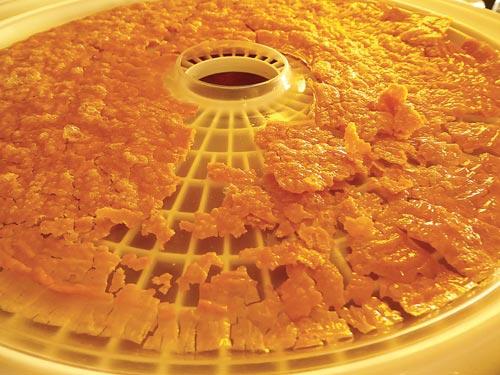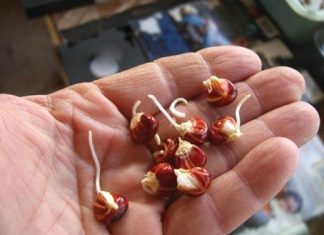 |
|
| Issue #156 • November/December, 2015 |
Here’s a trivia question for you: What do you do when your chickens are laying gangbusters and you have no less than 10 dozen eggs in the fridge, with more arriving daily?
Answer: Preserve them.
Despite the concerns in recent years about cholesterol and other issues, eggs are high in protein, potassium, and Vitamin A. Eaten in moderation, they’re an excellent addition to a balanced diet.
But 10 dozen eggs in the fridge? That’s a little much. I needed to preserve them. My only problem was deciding how to preserve them.
Over the years, people have used a variety of methods to preserve eggs oiling, water glassing, dry storage, small-side-down storage, freezing, pickling … each of these techniques has its pros and cons.
But I was particularly interested in dehydrating eggs, and set out to learn the best, safest, and easiest method of doing so.
Why dehydrate? Oddly enough, it’s because we don’t eat a lot of fresh eggs in our family. In the last year, I can count on one hand how many times someone has cracked an egg into a pan and eaten it for breakfast.
But baking … ah, that’s different. We use eggs constantly for baking and cooking projects, and dehydrated eggs reportedly worked well for these purposes. Drying seemed like the best preserving solution for our needs.
Dehydrated (powdered) eggs are a staple on almost every preparedness food storage list, but have you seen the prices? On Amazon.com, one brand of “whole powdered eggs” in a #10 can sold for $90. Another brand of “scrambled egg mix” in a #10 can (which contained 92 servings) retailed for $177. Assuming a “serving” is one egg, this means even at the lower price, the cost is $12/dozen.
That’s a lot of money to spend for a few dozen powdered eggs, but I had to admit the compact nature of dehydration was attractive. With such an abundance of our own farm-fresh eggs, we decided to give home dehydrating a try.
Despite the widespread, easy-to-find online information on dehydrating eggs, nearly everyone admitted salmonella was still a potential problem. Yet powdered eggs are sold commercially all the time. Surely there was a way to make safe home-dehydrated eggs?

I took five eggs at a time and blended them in a blender for a few seconds, then poured the liquified eggs carefully on the fruit roll sheet on each tray.
Dehydration techniques
Commercially, dehydrated eggs are made by a technique called spray drying, where the liquefied eggs are first pasteurized, then dispersed through a spray nozzle or atomizer into a heated tank environment. Water is evaporated and the egg solids (already in powder form) collect at the bottom of the containment tank.
Additionally, commercially-dehydrated eggs are also “de-sugared,” which helps preserve the quality and appearance of the dried eggs. Without removing the sugars, dried eggs have a different color and different characteristics.
For home dehydration, there are two tried and true techniques to dry eggs: the cook-dry method and the wet-dry method.
For the cook-dry method, eggs are beaten (scrambled) and cooked in a pan. The cooked scrambled eggs are dehydrated for about four hours until brittle, then pulverized in a blender or food processor. Numerous online tutorials have admitted the results are inferior, though the shorter dehydration time was a benefit.
The technique with better results is the wet-dry method, and that is the technique discussed in this article.
To dehydrate eggs using the wet-dry method, eggs are beaten, spread on a fruit-roll sheet in a dehydrator for about 10 to 12 hours, then pulverized into powder using a blender. Simple, right?
Right … except everyone using this easy technique admitted the potential for salmonella poisoning.
In short, you don’t want to risk salmonella poisoning just to save a few bucks by dehydrating your own eggs. Remember, the goal is not just to dry eggs (you can do that in the sun). The goal is to dehydrate eggs in the safest possible manner. So what’s the best, safest, most palatable way to dehydrate?

Once fully dry, the eggs are dark orange and resemble thin peanut brittle.
Watch those numbers
The key, it seems, is temperature. Eggs dehydrate easily, and most online sources suggest keeping the eggs at 135° F to 145° F for about 10 hours. However this temperature is not sufficient to keep salmonella from forming during the dehydration process, because this leaves eggs in the food safety danger zone for too long.
Numerous USDA studies indicate the safest temperature for eggs during any process (cooking, baking, whatever) is a minimum of 160° F. From this I concluded a minimum of 160° F, and preferably 165° F, would be sufficient to render home-dehydrated eggs safe.
We purchased a digital oven thermometer, and I blended some eggs and spread them on cookie sheets and dehydrated them in our kitchen oven, being careful to maintain the temperature as close as possible to 165° F for 10 hours. I successfully dried a total of 18 eggs (on three sheets) using this technique.
However, with another nine dozen eggs in the fridge waiting to be dehydrated, this would mean I’d be running our oven for at least 66 hours. Also, maintaining the temperature that low (remember, ovens are meant to get much hotter) required constant vigilance and adjustment. It didn’t seem cost-efficient to use that much propane just to dehydrate some eggs. A dehydrator was the far better option.
We were in the market for a dehydrator anyway, so I decided to get a model which would allow me to safely dehydrate eggs. I learned the vast majority of dehydrators, including expensive higher-end models, simply do not reach 165° F. After a bit of research, I found a Presto Digital Electric Dehydrator (model 06301) which met my requirements for the very reasonable price of $65. I also purchased extra accoutrements (nonstick mesh screens and extra fruit roll sheets). With shipping, my total came to just under $100.
Keep in mind, the cheapest #10 can of commercially-dehydrated eggs (with shipping) is about the same price.

I used our mini food processor to grind the dried eggs.
Dehydration process
Once I received the dehydrator, I started the process of dehydrating my vast egg supply. The dehydrator came with six trays. Although most online sources indicate six eggs can be dried per tray, I found this to be just a bit too much liquid (it almost overflowed), and settled on five eggs per tray. This meant I could dry 30 eggs at a time.
Some people recommended lightly oiling or using cooking oil spray on the sheets. This was entirely unnecessary, at least for the fruit roll sheets that came with this particular dehydrator.
I initially set up the dehydrator in the kitchen for the first batch. However, it was noisy enough that for all subsequent batches, I set up the dehydrator in a spare room where I could close the door.
At this point, dehydrating was easy. I put five eggs at a time into the blender, frothed them up for a few seconds, then carefully poured the liquefied eggs onto a fruit roll sheet on a tray. Once the dehydrator was full, I set the temperature at 165° F for ten hours and walked away.
After the eggs were dried, they resembled thin peanut brittle. They also turned a dark orange (remember, since the eggs weren’t “de-sugared,” the color changed). The dried eggs slid off the fruit roll sheets very easily, and after they cooled I ground them in a food processor to a grain-like consistency. The dried eggs have a slightly greasy feel (this is normal).
Thirty eggs came to about four cups of dehydrated egg granules.
What about Salmonella?
Salmonella is a nasty bacterium which can make people ill through eating contaminated food. Eggs (along with beef, poultry, and milk) are particularly susceptible to salmonella. Symptoms of poisoning include diarrhea, fever, and abdominal cramps which develop 12 to 72 hours after infection, and can last up to a week. (My dear husband got salmonella poisoning on our honeymoon.) While most people recover without treatment, sometimes it’s necessary to be hospitalized to control the resulting dehydration. To make things more fun, it generally takes several months before “bowel habits are entirely normal.” Occasionally even more severe complications can result as well, such as Reiter’s syndrome.
Storage
The next question to arise was that of long-term storage of the dehydrated eggs. I considered dry-canning (in a pressure canner) the powdered eggs in half-pint jars for ease of use, but wasn’t sure if this was possible. So I sought the advice of a canning expert, who shall remain unnamed since she made it clear her advice was not to be construed as “official.” She said, “There would be no reason to subject dried eggs to the heat of a canning process. Dry-canning them would only be for the purpose of creating a vacuum seal on the jar (there is no established pathogen kill, which also is not necessary if they are dry enough for air-tight storage at room temperature). It is the removal of moisture that makes these safe to store at room temperature. The heat of canning would be detrimental to their quality (color, taste, nutrition). I can’t tell you how much or exactly how, but we know their pigments and some vitamins are adversely affected by heat. If they are successfully dried, there is no need to worry about canning for safe storage, and they can be vacuum packaged by other mechanical means these days.”
So dry-canning dehydrated eggs was out. That left either freezing or packing in an oxygen-deprived cool dark environment as the best options for long-term storage.
How long do dehydrated eggs last? According to the American Egg Board (www.aeb.org), “Plain whole egg solids [powdered eggs] have a shelf life of about one month at room temperature and about a year at refrigerated temperatures.”
Properly stored in an oxygen-free environment and kept cool and dark, dehydrated eggs allegedly have a storage life of five to 10 years. I stored some of my dried eggs in a dark pantry in pint jars with an oxygen absorber in the jar. I also have some stored in the freezer.
But do they work?
So how do dehydrated eggs work in baking projects?
Dehydrated eggs can simply be used in powder form for baking, but I opted to rehydrate first. This is a simple matter of a two-to-one ratio of water to powdered eggs and letting the mixture stand for a few minutes. For the equivalent of a single egg, use one tablespoon of egg powder and two tablespoons water.
A rehydrated egg has a grainy appearance, but it behaves in the same way as a fresh egg in cooking.
To test this, I made two identical batches of cornmeal muffins. I measured each batch as precisely as possible. The results looked and tasted identical. I gave my daughter a blind taste test, and she couldn’t tell the difference.
But what about a fresh-taste comparison? I blended two fresh eggs with ¼ cup of water and pan-scrambled them. Then I rehydrated two tablespoons of dehydrated eggs with four tablespoons water, let the mixture stand for about five minutes, then added a bit more water and scrambled them.
The results were revolting. Not only did the rehydrated eggs “scramble” at about half the volume of the fresh eggs, but the taste was grainy and bad enough for me to swish my mouth out with water after one bite.
Somewhere online I saw a recommendation that eggs can be reconstituted with milk for better scrambled egg results. I tried this, and the results were just as bad.
Other people have had more success in cooking dehydrated eggs as scrambles or omelets; but since my original purpose was to preserve eggs for baking purposes under emergency conditions (or simply when I ran short on fresh eggs), I’m satisfied enough to continue dehydrating my surplus eggs.

To test the dehydrated eggs in baking, I made two identical batches of cornmeal muffins. There was no difference!
Conclusion
So is it worthwhile to dehydrate eggs?
From a cost standpoint, the answer is unequivocally “yes,” but only if you keep your own hens to begin with. If you’re buying eggs from the store, it’s far less cost-efficient and you’d probably be better off purchasing commercially-dehydrated eggs.
Aside from the cost of the dehydrator which will be amortized over time and which can be used to dehydrate endless other foods (beef jerky is our next project) the cost of the dehydrated eggs comes down to the cost of the electricity to run the machine, and the cost of feeding the chickens. For the homesteader already keeping a flock of hens, that’s the closest to “free” anyone can reasonably expect.
From a quality standpoint, dehydrated eggs were a flop for “fresh” consumption (as my husband put it, he’ll never ask for “two powdered eggs over easy”), but they were a resounding success for baking and cooking.
Overall, I plan to continue using fresh eggs for day-to-day uses, and dehydrate any surplus eggs for emergency or preparedness purposes.
However, this is where I will insert the obligatory safety warnings.
I spoke to two food safety experts in the writing of this article, both of whom asked not to be identified or to have their conversation reported as official recommendations. This was for the very good reason that these experts could not confirm or endorse the safety procedures of dehydrating eggs at home.
Commercially-dehydrated eggs have a number of built-in safety procedures and techniques not available to the home dehydrator. Therefore I feel compelled to conclude by saying that anyone dehydrating their own eggs is doing so at his or her own risk.















We have a freeze dryer and freeze dry eggs all the time. They rehydrate just fine and you can’t tell the difference between the freeze dried eggs and fresh. I have scrambled them and used them for baking.
Although I’d love to have free-range eggs, prepping eggs this way is far more cost effective with eggs from the store in my area costing $2.38 for a 60-pack as opposed to our farm-raised eggs last year costing $2 dozen for the supplemental feed. Also, another site had recommended to further dehydrate another 2 hours after powdering the eggs. I enjoy reading your articles and love the different methods and views you provide!
I dry eggs for my long term storage for my dogs. They eat naturally. I scramble them, and bake them in a corning type dish on paper. Once cooked, I break them up into small pieces and dry. Then they go into the processor. I store them in canning jars with dry pack and oxygen absorbers, and keep them in a dark cool room. I have used them as long as a year out with no issues. They come out a nice color like that unless you over do the heat on drying and that will darken them. I have eaten them dry without re-hydrating them and they are good, but rehydrated they have a odd consistency and unless I was really hungry I would not eat them. I prefer fresh, but putting two TBs in a dogs meal with other stuff is really easy. And for hiking with your dog a great way to feed without he heavy bulk. Just some thoughts.
Try mixing your powdered eggs with fresh eggs 50-50 ratio. It also helos to add goodie such as baccon, ham, cheese, onions, grated potato, garlic powder, onion powder, salt & pepper. That might help your results. At least it works with commercial powdered eggs.
Why not just pasturize the eggs then dehydrate? I pasturize eggs at home for other uses.
Food poisoning, ie Salmonella, is not only about the bacteria. When the bacteria is allowed to grow for 10hrs at ideal temps, under 160F, it will be living, breathing, reproducing and ‘pooping’ in the eggs. The poop is what makes a person sick. So yes, you can cook the eggs and kill the bacteria, but the poop does not disappear.
I was genuinely surprised you keep your eggs in the fridge, where they eat up a metric ton of room. Unwashed clean eggs keep at room temperature just fine for several weeks, to months.
I think I have the same model of dehydrator. It really is LOUD. I ran it outside on my patio during the summer months, and have set it up in a spare room for the winter.
Will heating the finish product in the oven for 275°F for 10 minutes get rid of any botulism? It was mentioned in a youtube on making chicken jerky.
Wouldn’t it be possible, once the eggs are dry, to heat the powdered eggs in the oven to sterilize them? Heating the dried eggs wouldn’t cook them.
I’d like to know how the eggs did in custards? Bread pudding? Pumpkin pie? Pecan pie? Quiche?
I was thinking while reading your article, that if you only use your eggs for baking, the high temp of the oven should kill any salmonella that might possibly be in the dried eggs. Not sure if any of your sources mentioned that or not. What do you think? I am planning on drying some of my excess eggs as well and safety is one of my concerns. I also noticed this article was written in 2015. ANy updates since then?